
Commelinales is an order of flowering plants. It comprises five families: Commelinaceae, Haemodoraceae, Hanguanaceae, Philydraceae, and Pontederiaceae. All the families combined contain over 885 species in about 70 genera; the majority of species are in the Commelinaceae. Plants in the order share a number of synapomorphies that tie them together, such as a lack of mycorrhizal associations and tapetal raphides. Estimates differ as to when the Commelinales evolved, but most suggest an origin and diversification sometime during the mid- to late Cretaceous. Depending on the methods used, studies suggest a range of origin between 123 and 73 million years, with diversification occurring within the group 110 to 66 million years ago. The order's closest relatives are in the Zingiberales, which includes ginger, bananas, cardamom, and others.

Ceratophyllaceae is a cosmopolitan family of flowering plants including one living genus commonly found in ponds, marshes, and quiet streams in tropical and in temperate regions. It is the only extant family in the order Ceratophyllales. Species are commonly called coontails or hornworts, although hornwort is also used for unrelated plants of the division Anthocerotophyta.

The Francoaceae are a small family of flowering plants in the order Geraniales, including the genera Francoa, commonly known as bridal wreaths, and Tetilla. The Francoaceae are recognized as a family under various classification schemes but under the APG III system the Francoaceae are included within the Melianthaceae. In the APG IV system the Francoaceae are again recognized as a family, with Melianthaceae included in the circumscription of Francoaceae.

The Bixaceae are a family of dicotyledonous plants commonly called the achiote family. Under the Cronquist system, the family was traditionally placed in the order Violales. However, newer arrangements move it, with some other families previously in the Violales, into the Malvales.

Burmanniaceae is a family of flowering plants, consisting of 99 species of herbaceous plants in eight genera.

Asphodelaceae is a family of flowering plants in the order Asparagales. Such a family has been recognized by most taxonomists, but the circumscription has varied widely. In its current circumscription in the APG IV system, it includes about 40 genera and 900 known species. The type genus is Asphodelus.
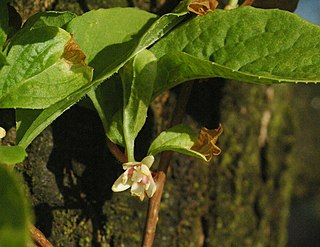
Schisandraceae is a family of flowering plants with 3 known genera and a total of 92 known species. Such a family has been recognized by most taxonomists, at least for the past several decades. Before that, the plants concerned were assigned to family Magnoliaceae and Illiciaceae.

Asparagaceae, known as the asparagus family, is a family of flowering plants, placed in the order Asparagales of the monocots. The family name is based on the edible garden asparagus, Asparagus officinalis. This family includes both common garden plants as well as common houseplants. The garden plants include asparagus, yucca, bluebell, and hosta, and the houseplants include snake plant, corn cane, spider plant, and plumosus fern.

Juncaginaceae is a family of flowering plants, recognized by most taxonomists for the past few decades. It is also known as the arrowgrass family. It includes 3 genera with a total of 34 known species.
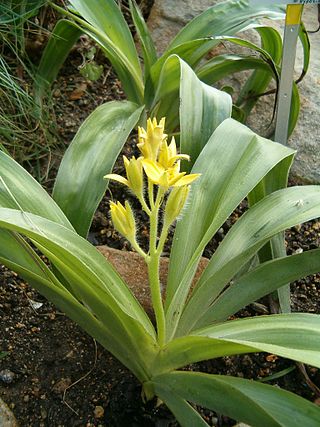
Hypoxidaceae is a family of flowering plants, placed in the order Asparagales of the monocots.

Chloranthaceae is a family of flowering plants (angiosperms), the only family in the order Chloranthales. It is not closely related to any other family of flowering plants, and is among the early-diverging lineages in the angiosperms. They are woody or weakly woody plants occurring in Southeast Asia, the Pacific, Madagascar, Central and South America, and the West Indies. The family consists of four extant genera, totalling about 77 known species according to Christenhusz and Byng in 2016. Some species are used in traditional medicine. The type genus is Chloranthus. The fossil record of the family, mostly represented by pollen such as Clavatipollenites, extends back to the dawn of the history of flowering plants in the Early Cretaceous, and has been found on all continents.

Dasypogonaceae is a family of flowering plants based on the type genus Dasypogon, one that has traditionally not been commonly recognized by taxonomists; the plants it contains were usually included in the family Xanthorrhoeaceae. If valid, Dasypogonaceae includes four genera with 16 species. The family is endemic to Australia. The best known representative is Kingia australis.
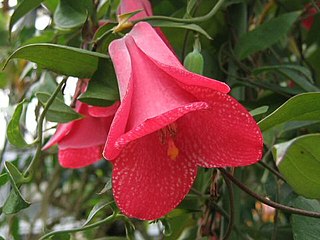
Philesiaceae is a family of flowering plants, including two genera, each with a single species. The members of the family are woody shrubs or vines endemic to southern Chile.
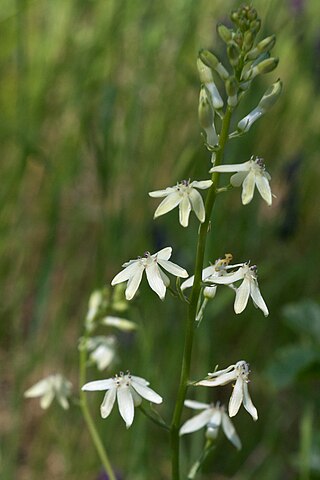
Tecophilaeaceae is a family of flowering plants, placed in the order Asparagales of the monocots. It consists of nine genera with a total of 27 species.

The Anarthriaceae was a family of three genera, Anarthria, Hopkinsia and Lyginia of flowering plants, now included in Restionaceae following APG IV (2016). The family is accepted in the Angiosperm Phylogeny Group's classification system, APG III system, but is not considered a separate family in many other taxonomic systems. The three genera are herbaceous but differ greatly in characteristics.

The Ecdeiocoleaceae comprise a family of flowering plants with two genera and three species. The botanical name has rarely been recognized by taxonomists.

Medusandra is a genus of flowering plants in the family Peridiscaceae. It has two species, Medusandra richardsiana and Medusandra mpomiana. M. richardsiana is the most common and well known. Both species are native to Cameroon and adjacent countries.
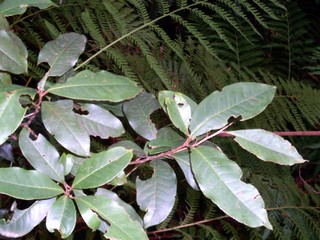
The Paracryphiaceae are a family of woody shrubs and trees native to Australia, southeast Asia, and New Caledonia. In the APG III system of 2009, the family is placed in its own order, Paracryphiales, in the campanulid clade of the asterids. In the earlier APG II system, the family was unplaced as to order and included only Paracryphia.

The Torricelliaceae are a family of trees native to Madagascar and southwest Asia. It contains three genera, Aralidium, Melanophylla and Torricellia. Under the APG II system, each of these genera was placed in its own family, but with the proviso that "Some of the families are monogeneric and could possibly be merged when well-supported sister-group relationships have been established." Such a relationship was established for these three genera in 2004. In the APG III system, these three genera constitute the family Torricelliaceae.

Huaceae is a family of plant in the rosids group, which has been classed in the orders Malpighiales, Malvales, and Violales or in its own order Huales. The APG II system placed it in the clade eurosids I, whereas the APG III system of 2009 and APG IV (2016) place it within the Oxalidales. The family is endemic to central Africa. It contains four species in the following two genera:



















